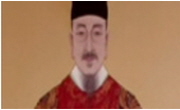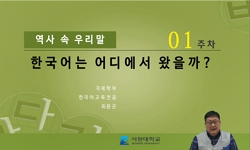『훈민정음』 해례본에는 훈민정음이 창제되는 과정이 기술되어 있는데, 거기에는 기표가 지시물을 나타내는 기호작용의 법칙이 드러난다. 이 글에서 필자는 기표와 지시물 간의 도상적 관...
http://chineseinput.net/에서 pinyin(병음)방식으로 중국어를 변환할 수 있습니다.
변환된 중국어를 복사하여 사용하시면 됩니다.
- 中文 을 입력하시려면 zhongwen을 입력하시고 space를누르시면됩니다.
- 北京 을 입력하시려면 beijing을 입력하시고 space를 누르시면 됩니다.
https://www.riss.kr/link?id=A105295822
- 저자
- 발행기관
- 학술지명
- 권호사항
-
발행연도
2018
-
작성언어
Korean
-
주제어
훈민정음 ; 신화성 ; 반신화성 ; 뮈토스 ; 로고스 ; 뮈토세미오시스 ; 도상기호 ; Hunminjeongeum ; mythicality ; anti-mythicality ; mythos ; logos ; mythosemiosis ; Icon
-
등재정보
KCI등재
-
자료형태
학술저널
-
수록면
93-117(25쪽)
-
KCI 피인용횟수
1
- DOI식별코드
- 제공처
-
0
상세조회 -
0
다운로드
부가정보
국문 초록 (Abstract)
신화적 유형은 당시의 지식층의 사유를 지배했던 음양오행과 천지인 삼재의 원리로 나타난다. 이러한 원리에 군주의 절대적 권력이 결합하여, 그것은 더 이상 논박 가능한 로고스가 아닌 절대적 믿음의 대상인 뮈토스가 된다. 그것은 매우 형이상학적이며 또한 거대서사를 감추고 있다. 그것은 과거로부터 이어져온 목소리이며, 또한 지역적으로는 중국으로부터 비롯된 것이다. 그것이 훈민정음의 소리(글자) 체계에 그대로 반영된다.
그러나 한편으로 훈민정음의 도상기호의 생성에는 반신화적 유형이 개입되기도 한다. 훈민정음은 절대적 권력을 가진 세종이라는 군주의 기획에 의해 만들어진 것이지만, 그 의도가 매우 계몽적이며 실용적이다. 그것은 과거의 문제가 아닌 당대의 문제이며, 특정 권력 계층이 아닌 일반 계층에 대한 수혜의 차원에서 이루어진 것이다. 당대의 실제적 상황에서 기획되고 진행된 것이라는 점에서, 그것은 로고스에 해당하는 것이다. 실제로 최만리 등과의 담론적 투쟁도 있었는데, 이는 훈민정음이 로고스적 인식에 의해 창제되었음을 보여주는 것이기도 하다. 무엇보다도 훈민정음의 도상기호에서 지시물은 인간의 발성기관인데, 이는 그 도상기호가 ‘몸으로부터 나온 소리는 그 몸과 닮는다’는 실제적인 지표성을 함의하고 있음을 보여주는 것으로, 신화적 유형에 지배된 형이상학이나 거대서사가 해체되는 모습을 보이는 것이다.
이후, 훈민정음은 그것이 쓰이는 순간부터, 그것이 기댔던 형이상학이나 거대서사의 뮈토스가 해체되고, 백성들을 편케 하는 실용적 기호로서 무한한 가능성을 발휘하게 된다. 오늘날 우리가 한글을 통해 구현할 수 있는 문화적 가능성은 끊임없이 생성되는 뮈토스에 대한 이러한 로고스의 해체를 통해 실현될 수 있다.
『훈민정음』 해례본에는 훈민정음이 창제되는 과정이 기술되어 있는데, 거기에는 기표가 지시물을 나타내는 기호작용의 법칙이 드러난다. 이 글에서 필자는 기표와 지시물 간의 도상적 관계에 주목하여, 이에 작용하는 신화적 유형과 반신화적 유형에 대해 고찰하고자 한다.
신화적 유형은 당시의 지식층의 사유를 지배했던 음양오행과 천지인 삼재의 원리로 나타난다. 이러한 원리에 군주의 절대적 권력이 결합하여, 그것은 더 이상 논박 가능한 로고스가 아닌 절대적 믿음의 대상인 뮈토스가 된다. 그것은 매우 형이상학적이며 또한 거대서사를 감추고 있다. 그것은 과거로부터 이어져온 목소리이며, 또한 지역적으로는 중국으로부터 비롯된 것이다. 그것이 훈민정음의 소리(글자) 체계에 그대로 반영된다.
그러나 한편으로 훈민정음의 도상기호의 생성에는 반신화적 유형이 개입되기도 한다. 훈민정음은 절대적 권력을 가진 세종이라는 군주의 기획에 의해 만들어진 것이지만, 그 의도가 매우 계몽적이며 실용적이다. 그것은 과거의 문제가 아닌 당대의 문제이며, 특정 권력 계층이 아닌 일반 계층에 대한 수혜의 차원에서 이루어진 것이다. 당대의 실제적 상황에서 기획되고 진행된 것이라는 점에서, 그것은 로고스에 해당하는 것이다. 실제로 최만리 등과의 담론적 투쟁도 있었는데, 이는 훈민정음이 로고스적 인식에 의해 창제되었음을 보여주는 것이기도 하다. 무엇보다도 훈민정음의 도상기호에서 지시물은 인간의 발성기관인데, 이는 그 도상기호가 ‘몸으로부터 나온 소리는 그 몸과 닮는다’는 실제적인 지표성을 함의하고 있음을 보여주는 것으로, 신화적 유형에 지배된 형이상학이나 거대서사가 해체되는 모습을 보이는 것이다.
이후, 훈민정음은 그것이 쓰이는 순간부터, 그것이 기댔던 형이상학이나 거대서사의 뮈토스가 해체되고, 백성들을 편케 하는 실용적 기호로서 무한한 가능성을 발휘하게 된다. 오늘날 우리가 한글을 통해 구현할 수 있는 문화적 가능성은 끊임없이 생성되는 뮈토스에 대한 이러한 로고스의 해체를 통해 실현될 수 있다.
다국어 초록 (Multilingual Abstract)
The mythical type is shown as Yin-Yang and the Five Elements Theory and Three Elements Theory of Heaven, Earth and Man dominating the thought of intellectuals at that time. It had became mythos, that is the object of absolute belief, by connecting with the power of King at that time. It is very metaphysical and involves a kind of grand narrative. It is also the voice from the past in time and from China in space. It is reflected in Hunminjeongeum’s letter system intactly.
Meanwhile, the anti-mythical type also affects the creation of Icon in Hunminjeongeum. Even if Hunminjeongeum had been created from King Sejong’s project, its intention seemed to be educational and practical. That is the problem of that time, not of past time, and for common class, not for ruling class. It can be considered as logos in that it had been planned and processed at a real-life situation at that time. Some arguments between King Sejong and liege Choi, Manri about the validity of Hunminjeongeum also show that the creation of Hunminjeongeum had involved the problem of critical logos. Above all, in that referents of Icons of Hunminjeongeum are the figures of human vocal organs, we can suggest that these Icons also implied an Indexicality implying actual connection between voice and body. It can be considered as a deconstrucion of metaphysics and grand narrative that had been dominated by foresaid mythical type.
Hereafter, from time when Hunminjeongeum have been widely used, mythos of metaphysics and grand narrative that had dominated Hunminjeongeum have been deconstructed and Hunminjeongeum has become to realize its potential competence of pragmatic sign system for the convenience of common people. Therefore, I expect that the cultural potentiality of Hangul today can be realized by such tendency of logos incessantly deconstructing mythos, that is one direction of mythosemiosis.
The process of creating Hunminjeongeum described in Haerye version of Hunminjeongeum shows a rule of signification by which a signifiant represents a referent. In this article, I will suggest two types, the mythical and the anti-mythical, that affect ...
The process of creating Hunminjeongeum described in Haerye version of Hunminjeongeum shows a rule of signification by which a signifiant represents a referent. In this article, I will suggest two types, the mythical and the anti-mythical, that affect the iconic relation between signifiant and referent, and consider how they are realized in Hunminjeongeum.
The mythical type is shown as Yin-Yang and the Five Elements Theory and Three Elements Theory of Heaven, Earth and Man dominating the thought of intellectuals at that time. It had became mythos, that is the object of absolute belief, by connecting with the power of King at that time. It is very metaphysical and involves a kind of grand narrative. It is also the voice from the past in time and from China in space. It is reflected in Hunminjeongeum’s letter system intactly.
Meanwhile, the anti-mythical type also affects the creation of Icon in Hunminjeongeum. Even if Hunminjeongeum had been created from King Sejong’s project, its intention seemed to be educational and practical. That is the problem of that time, not of past time, and for common class, not for ruling class. It can be considered as logos in that it had been planned and processed at a real-life situation at that time. Some arguments between King Sejong and liege Choi, Manri about the validity of Hunminjeongeum also show that the creation of Hunminjeongeum had involved the problem of critical logos. Above all, in that referents of Icons of Hunminjeongeum are the figures of human vocal organs, we can suggest that these Icons also implied an Indexicality implying actual connection between voice and body. It can be considered as a deconstrucion of metaphysics and grand narrative that had been dominated by foresaid mythical type.
Hereafter, from time when Hunminjeongeum have been widely used, mythos of metaphysics and grand narrative that had dominated Hunminjeongeum have been deconstructed and Hunminjeongeum has become to realize its potential competence of pragmatic sign system for the convenience of common people. Therefore, I expect that the cultural potentiality of Hangul today can be realized by such tendency of logos incessantly deconstructing mythos, that is one direction of mythosemiosis.
참고문헌 (Reference)
1 김주원, "훈민정음 : 사진과 기록으로 읽는 한글의 역사" 민음사 2013
2 송효섭, "해체의 설화학" 서강대학교 출판부 2009
3 송효섭, "신화의 질서 : 도상기호학적 탐구" 문학과지성사 2012
4 강신항, "수정증보 훈민정음연구" 성균관대학교 출판부 2003
5 "세종실록"
6 송효섭, "매체, 신화, 스토리텔링 - 매체의 통합, 분리, 횡단에 따른 뮈토-세미오시스의 지형" 한국기호학회 45 : 33-54, 2015
7 Groupe μ, "Traité du signe visuel : Pour une rhétorique de l’image" Seuil 1992
8 Greimas, A. J., "Sémantique structurale" Larousse 1966
9 Derrida, Jacques, "Of Grammatology" The Johns Hopkins University Press 1974
10 Hénault, Anne, "Narratologie, sémiotique générale" PUF 1983
1 김주원, "훈민정음 : 사진과 기록으로 읽는 한글의 역사" 민음사 2013
2 송효섭, "해체의 설화학" 서강대학교 출판부 2009
3 송효섭, "신화의 질서 : 도상기호학적 탐구" 문학과지성사 2012
4 강신항, "수정증보 훈민정음연구" 성균관대학교 출판부 2003
5 "세종실록"
6 송효섭, "매체, 신화, 스토리텔링 - 매체의 통합, 분리, 횡단에 따른 뮈토-세미오시스의 지형" 한국기호학회 45 : 33-54, 2015
7 Groupe μ, "Traité du signe visuel : Pour une rhétorique de l’image" Seuil 1992
8 Greimas, A. J., "Sémantique structurale" Larousse 1966
9 Derrida, Jacques, "Of Grammatology" The Johns Hopkins University Press 1974
10 Hénault, Anne, "Narratologie, sémiotique générale" PUF 1983
11 Hartshorne, Charles, "Collected Papers of Charles Sanders Peirce" Harvard University Press 1960
12 Eco, Umberto, "A Theory of Semiotics" Indiana University Press 1979
동일학술지(권/호) 다른 논문
-
찰스 S. 퍼스와 마이클 폴라니의 회의론과 믿음(belief)에 대한 비교 연구
- 한국기호학회
- 김동주 ( Kim Dong Ju )
- 2018
- KCI등재
-
한국전통춤에서 동물모방의 문화기호학적 표상에 관한 연구
- 한국기호학회
- 김지원 ( Kim Ji Won )
- 2018
- KCI등재
-
- 한국기호학회
- 박영원 ( Park Young-won )
- 2018
- KCI등재
-
무속신화 <바리공주> 서사의 다층적 이해 - 이야기·생성·소통의 세 층위를 대상으로
- 한국기호학회
- 오세정 ( Oh Sejeong )
- 2018
- KCI등재
분석정보
인용정보 인용지수 설명보기
학술지 이력
| 연월일 | 이력구분 | 이력상세 | 등재구분 |
|---|---|---|---|
| 2027 | 평가예정 | 재인증평가 신청대상 (재인증) | |
| 2021-01-01 | 평가 | 등재학술지 유지 (재인증) |  |
| 2018-01-01 | 평가 | 등재학술지 유지 (등재유지) |  |
| 2015-01-01 | 평가 | 등재학술지 유지 (등재유지) |  |
| 2011-01-01 | 평가 | 등재 1차 FAIL (등재유지) |  |
| 2009-01-01 | 평가 | 등재학술지 유지 (등재유지) |  |
| 2006-01-01 | 평가 | 등재학술지 선정 (등재후보2차) |  |
| 2005-05-29 | 학술지명변경 | 외국어명 : semiotic inquiry -> Semiotic Inquiry |  |
| 2005-01-01 | 평가 | 등재후보 1차 PASS (등재후보1차) |  |
| 2003-01-01 | 평가 | 등재후보학술지 선정 (신규평가) |  |
학술지 인용정보
| 기준연도 | WOS-KCI 통합IF(2년) | KCIF(2년) | KCIF(3년) |
|---|---|---|---|
| 2016 | 0.72 | 0.72 | 0.66 |
| KCIF(4년) | KCIF(5년) | 중심성지수(3년) | 즉시성지수 |
| 0.6 | 0.59 | 1.335 | 0.14 |





 KISS
KISS





